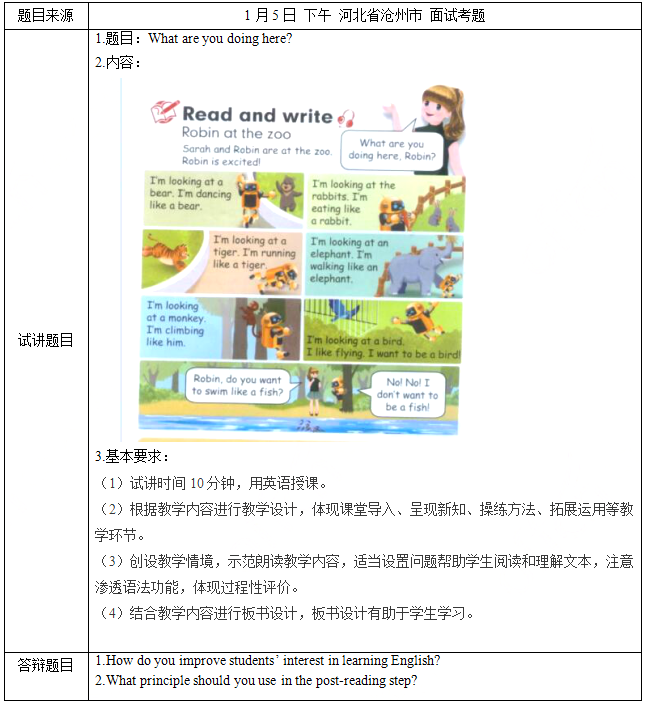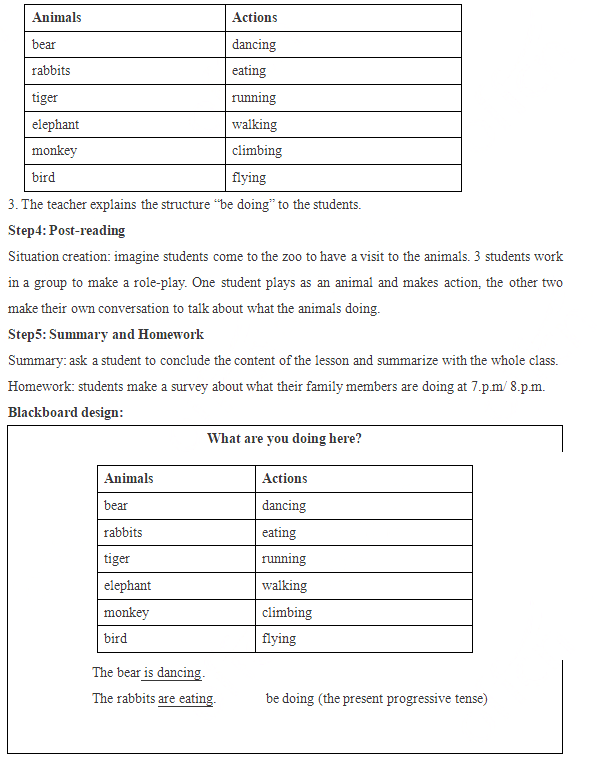小学英语?阅读一、考题回顾二、考题解析【教学设计】Teaching aims:Knowledge aim:Students will master the meaning and usage of the structure “be doing” through reading the passage.Ability aim:Students will apply the “be doing” to communicate with each other in real situation.Emotional aim:Students will be more interest in learning English.Key and difficult point:Key Point: Students will master how to improve reading abilities through finding main idea and details.Difficult Point: Students will apply the “be doing” to communicate with each other in real situation.Teaching procedure:Step 1: Warming-up1. Greetings.2. Play a riddle and students guess the animals, such as “long nose, big ears and strong body——elephant”, then lead to the topic of “let’s go to the zoo to see what animals are doing”.Step 2: Pre-reading1. According to the title, students have a prediction about what kinds of animals are mentioned in the passage.Step 3: While-reading1. Fast reading: students read the passage fast and figure out what kinds of animals are mentioned in the passage then make a list.2. Careful reading: students read the passage carefully and answer the question: what are the animals doing? Then fill in the blanks.1. How do you improve students’ interest in learning English?2. What principle should you use in the post-reading step?
小学英语?阅读
一、考题回顾

二、考题解析
【教学设计】
Teaching aims:
Knowledge aim:
Students will master the meaning and usage of the structure “be doing” through reading the passage.
Ability aim:
Students will apply the “be doing” to communicate with each other in real situation.
Emotional aim:
Students will be more interest in learning English.
Key and difficult point:
Key Point: Students will master how to improve reading abilities through finding main idea and details.
Difficult Point: Students will apply the “be doing” to communicate with each other in real situation.
Teaching procedure:
Step 1: Warming-up
1. Greetings.
2. Play a riddle and students guess the animals, such as “long nose, big ears and strong body——elephant”, then lead to the topic of “let’s go to the zoo to see what animals are doing”.
Step 2: Pre-reading
1. According to the title, students have a prediction about what kinds of animals are mentioned in the passage.
Step 3: While-reading
1. Fast reading: students read the passage fast and figure out what kinds of animals are mentioned in the passage then make a list.
2. Careful reading: students read the passage carefully and answer the question: what are the animals doing? Then fill in the blanks.

1. How do you improve students’ interest in learning English?
2. What principle should you use in the post-reading step?
一、考题回顾

二、考题解析
【教学设计】
Teaching aims:
Knowledge aim:
Students will master the meaning and usage of the structure “be doing” through reading the passage.
Ability aim:
Students will apply the “be doing” to communicate with each other in real situation.
Emotional aim:
Students will be more interest in learning English.
Key and difficult point:
Key Point: Students will master how to improve reading abilities through finding main idea and details.
Difficult Point: Students will apply the “be doing” to communicate with each other in real situation.
Teaching procedure:
Step 1: Warming-up
1. Greetings.
2. Play a riddle and students guess the animals, such as “long nose, big ears and strong body——elephant”, then lead to the topic of “let’s go to the zoo to see what animals are doing”.
Step 2: Pre-reading
1. According to the title, students have a prediction about what kinds of animals are mentioned in the passage.
Step 3: While-reading
1. Fast reading: students read the passage fast and figure out what kinds of animals are mentioned in the passage then make a list.
2. Careful reading: students read the passage carefully and answer the question: what are the animals doing? Then fill in the blanks.

1. How do you improve students’ interest in learning English?
2. What principle should you use in the post-reading step?
参考解析
解析:1.
In the process of English teaching, teachers should enrich the teaching approaches, not only teach students through "listening, speaking, reading", but also integrate situational teaching, so that students can feel the diversity of teaching and learning.
Besides, teachers can make use of the form of cooperative study and organize various practice activities in the classroom to create an atmosphere of mutual assistance and cooperation, so that students have positive sense of learning.
2.
First, we should persist in the communicative principle. In the production step of reading
class, students should be organized in groups to cultivate their speaking ability and communicative ability. In this way, we can reach the New Curriculum Standard.
Then, we should insist on the truth principle. That means we should provide more real materials that are closet to students’ real life, such as situation creation like what I did in this class. In this way, students’ interest can be aroused and they can apply what they’ve learned in real communication.
In the process of English teaching, teachers should enrich the teaching approaches, not only teach students through "listening, speaking, reading", but also integrate situational teaching, so that students can feel the diversity of teaching and learning.
Besides, teachers can make use of the form of cooperative study and organize various practice activities in the classroom to create an atmosphere of mutual assistance and cooperation, so that students have positive sense of learning.
2.
First, we should persist in the communicative principle. In the production step of reading
class, students should be organized in groups to cultivate their speaking ability and communicative ability. In this way, we can reach the New Curriculum Standard.
Then, we should insist on the truth principle. That means we should provide more real materials that are closet to students’ real life, such as situation creation like what I did in this class. In this way, students’ interest can be aroused and they can apply what they’ve learned in real communication.
相关考题:
Ⅱ.某乡镇中学有100名初一学生,他们先前所在小学均未开设英语。现拟对其进行 一项题为“多媒体教学对初一学生英语阅读成绩影响的研究”的真实验。请问:最好选用哪种实验设计(写出其名称和格式)?为什么?
认真阅读下列材料,并按要求作答。 根据上述材料完成下列任务:(1)简述英语儿歌的特点(2)如指导小学生学习,试拟定教学目标。(3)依据拟定的教学目标,设计导入和操练环节的教学活动并说明理由。
请认真阅读下列材料,并按要求作答。请根据上述材料完成下列任务:(1)简述在小学英语教学中应如何使用多媒体。(2)如指导小学生学习材料,试拟定教学目标。(3)依据拟定的教学目标,设计导入环节和新知呈现环节的教学活动并说明理由。
单选题教幼儿学英语应当从培养幼儿的()能力开始。A英语倾听B英语表述C英语阅读D英语书写